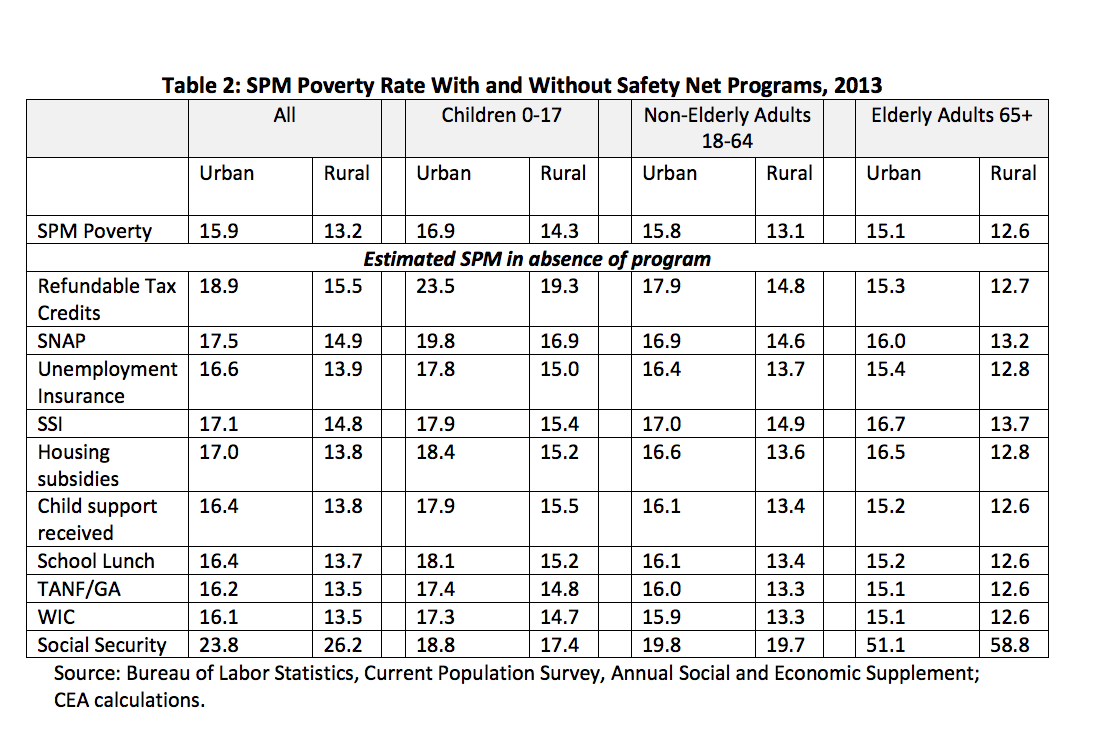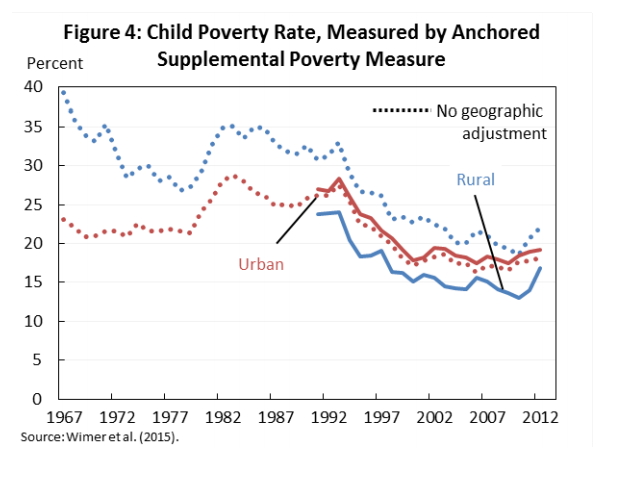Addressing rural child poverty is the subject of a recently launched White House “Rural Impact” initiative, including a recently published report highlighting the trends in rural poverty in the United States and plans to address the issue through various federal safety net programs and investments.
The Report — Opportunity for All: Fighting Rural Child Poverty
On May 20th, the White House released a report prepared by the Council of Economic Advisers, Domestic Policy Council, and Office of Management and Budget entitled: Opportunity for All: Fighting Rural Child Poverty (May 2015 Report).
The report was released during the Organization for Economic Cooperation and Development (OECD’s) tenth rural development policy conference, hosted by the White House Rural Council, with the support of the Atlantic Canada Opportunities Agency and Mexico’s Secretariat for Agrarian, Territorial and Urban Development.
The report examines trends in poverty and child poverty in the United States over the past fifty years, and highlights federal initiatives and programs that have helped rural communities and that President Obama plans to promote.
Although 6.2 million Americans in rural areas lived in poverty in 2013 (with 1.5 million of those being children), the May 2015 Report points to positive findings from a 2014 Council of Economic Advisers report demonstrating that several federal programs have cut poverty in rural areas by nearly half between 1967 and 2012, and by about one-quarter in urban areas.
The chart reflects the Supplemental Poverty Measure (SPM), in use by the Census Bureau since 2009, which takes into account a variety of government programs (Social Security, SNAP benefits, Earned Income Tax Credit, and the like) to identify families living below the poverty line once government transfers are counted. The SPM poverty threshold also includes food, shelter, clothing, and utilities – and not just food, among the expenditures counted in the poverty measure. And finally, the SPM poverty thresholds are adjusted for geographic variations in the cost of housing, which is important for comparisons of poverty between urban and rural areas.
SPM was developed to account for shortcomings in the Official Poverty Measure (OPM), which was developed in the 1960s and is based on families’ cash incomes relative to minimum expenses spent on necessities (i.e., food expenditures). As the report’s Table 1 shows below, the picture of relative rural and urban poverty is different depending on which poverty measure is used. Using SPM, the poverty rates for rural areas is less than that for urban areas. The report notes that this reversal is almost entirely driven by adjustments for differences in the cost of living, with average housing costs being lower in rural areas than in urban areas.

Of these federal programs that help Americans escape poverty, refundable tax credits have the largest anti-poverty effect on child poverty, lifting about 4.1 million urban and nearly 600,000 rural children from poverty.
Social Security plays a particularly large role in alleviating deep child poverty in rural areas, reducing deep poverty by nearly one-half (almost double its effect in urban areas). Social Security and Supplemental Security Income benefits are particularly important for rural children since many live with parents with a disability, or receive benefits as a survivor of a deceased parent. The impact of SNAP on deep poverty rates has been larger in rural areas than in the country as a whole.
According to the May 2015 Report, without Federal tax and transfer programs, child poverty in rural areas would have been more than 70 percent higher over the 2009 to 2011 period.

The Report also touches on several determinants of poverty, including education, the state of the local economy, job availability, family structure, and incarceration. Education’s role in poverty prevention has become increasingly important, as higher earnings have become tied to higher educational achievement. For example, in 1959, high school dropouts were 3.8 times more likely to be poor than college graduates, but in 2012, they were 6.1 times more likely to be poor (based on the SPM measure).
One change in the family structure that has led to reductions in the poverty rate over the past several decades has been the increase of women in the workforce and the increasing importance of women’s earnings to household income – both of which have increased stability in families’ incomes. However, another shift in the family structure since the 1960s that has led to a rise in poverty rates has been the decline in the proportion of married households and accompanying increase in the number of people living in single-parent households.
White House Agenda
President Obama’s agenda for assisting low-income rural children and their families is a bundle of existing and new programs to improve education, health, and earnings outcomes.
The existing programs include Head Start, the Preschool for All initiative, summer feeding programs, housing choice vouchers, and the Children’s Heath Insurance Program. Also named are the Promise Zones Initiative, a partnership between the federal government and local leaders in high poverty communities to improve the economy, education, public safety, public health and other locally-identified priorities, and USDA’s Strikeforce Initiative which is helping states dealing with chronic poverty create jobs, build homes, assist farmers, conserve natural resources, and implement feeding programs for kids.
Among the new programs or proposals are:
- Rural IMPACT: Rural Integration Models for Parents and Children to Thrive, a multi-agency program to explore innovative approaches to program delivery, with a goal of increasing parents’ employment and education and child and family well-being. The White House Rural Council will identify a group of 10 rural and tribal communities to test mechanisms for delivering health and human services – from childcare and pre-Kindergarten to postsecondary education and job training – to both children and parents concurrently.
- The Department of Health and Human Service’s Rural Child Poverty Telehealth Network Grant Program and USDA’s Distance Learning and Telemedicine Grant Program, announced in early May 2015, that seek to make health care more accessible to rural patients through the use of technology, with plans to award up to three pilot grants to test new ways to use telehealth technologies that link rural children with specialized health and human services that may not be available locally.
- A new competitive grant program to assist families with securing child care that is open to states, territories, tribes, and communities; and
- Making permanent the 2009 expansion of refundable credits (EITC and Child Tax Credits) set to expire in 2017, preventing a tax increase on 16 million working families with children, and doubling the childless worker EITC and expanding eligibility.
Initiatives to Help Native American Youth
The May 2015 Report draws special attention to the disparity in poverty among Native Americans, as compared with the rest of the nation, and the efforts by the Administration to address it. Some 22 percent of American Indian and Alaska Natives are living in poverty, compared to 16 percent for the nation (according to the SPM), nearly 60 percent of all Native Americans living outside of metropolitan areas live in persistently poor counties (according to the Economic Research Service at USDA), and Native youth experiencing a greater prevalence of poverty than any other racial and ethnic group. A 2014 White House initiative known as Generation Indigenous (Gen-I) will leverage existing and new programs to help Native youth prepare for college and careers and will also undertake a comprehensive reform of the Bureau of Indian Education (BIE) to improve BIE-funded schools.
Rural Impact Initiative
Announced in a White House Domestic Policy Council blog post in April 2015, the new Rural Impact initiative brings together federal agencies and public and private resources and organizations such as universities, foundations, non-profits, and community groups to address rural child poverty by focusing mainly on three major areas:
- Innovation: Developing new approaches of program delivery, including integrated services and remote health and learning technology, to address rural challenges and barriers;
- Awareness: Enhancing public awareness of rural child poverty and its impact on the future of rural communities and our nation’s global competitiveness; and
- Investment: Improving access to high-quality child care, early learning, and continuing education.
The Rural Impact Initiative includes several programs under the Innovation focus area that are not mentioned in the May 2015 Report, such as:
- The USDA Rural Child Poverty Nutrition Center at the University of Kentucky that was announced in March 2015 and will administer and evaluate sub-grantees to as many as 30 rural areas with high rates of persistent poverty in up to 15 states;
- A new round of Local Food, Local Places grants, a multi-agency program providing selected communities with resources and technical support, with a focus on helping increase access to healthy foods, including Farm to School, healthy food aggregation and distribution, and efforts to combat childhood obesity; and
- The launch of #ServeRural, a national effort to enlist volunteers and local organizations to help rural communities.
The Awareness focus area activities of Rural Impact will:
- Bring members of the Cabinet to areas of persistent rural poverty for a series of regional roundtables to highlight promising local practices and forge local and regional partnerships; and
- Report on the challenges and opportunities of addressing rural poverty through the May 2015 Report discussed above.
And finally, the Investment focus area of the Rural Impact initiative outlines many of the same proposals that are featured in the May 2015 Report, including free community college for responsible students, support for Head Start and public preschools, and making permanent the 2009 expansion of refundable credits (EITC and Child Tax Credits).


